大学英语写作课程语法unit1语法和练习答案
- 格式:doc
- 大小:36.00 KB
- 文档页数:5
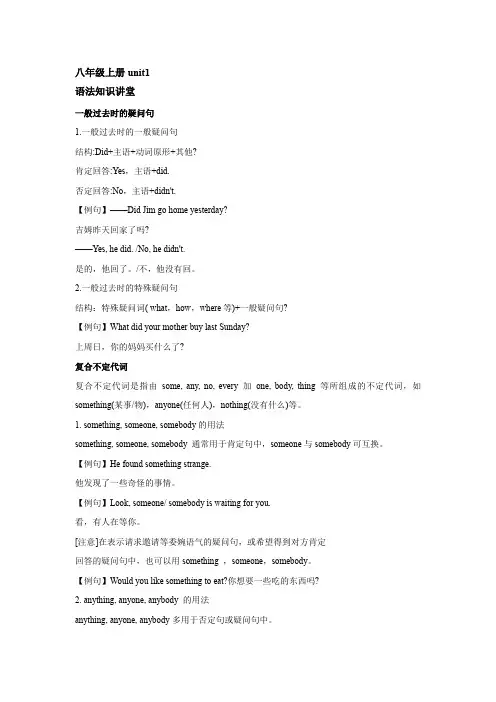
八年级上册unit1语法知识讲堂一般过去时的疑问句1.一般过去时的一般疑问句结构:Did+主语+动词原形+其他?肯定回答:Yes,主语+did.否定回答:No,主语+didn't.【例句】——Did Jim go home yesterday?吉姆昨天回家了吗?——Yes, he did. /No, he didn't.是的,他回了。
/不,他没有回。
2.一般过去时的特殊疑问句结构:特殊疑问词( what,how,where等)+一般疑问句?【例句】What did your mother buy last Sunday?上周日,你的妈妈买什么了?复合不定代词复合不定代词是指由some, any, no, every加one, body, thing等所组成的不定代词,如something(某事/物),anyone(任何人),nothing(没有什么)等。
1. something, someone, somebody的用法something, someone, somebody 通常用于肯定句中,someone与somebody可互换。
【例句】He found something strange.他发现了一些奇怪的事情。
【例句】Look, someone/ somebody is waiting for you.看,有人在等你。
[注意]在表示请求邀请等委婉语气的疑问句,或希望得到对方肯定回答的疑问句中,也可以用something ,someone,somebody。
【例句】Would you like something to eat?你想要一些吃的东西吗?2. anything, anyone, anybody 的用法anything, anyone, anybody多用于否定句或疑问句中。
【例句】I didn't meet anybody on the island.在岛上,我没遇见任何人。
![全新版大学英语综合教程(第二版)第一册_课文翻译与课后答案[1]](https://uimg.taocdn.com/0f4ac8f7e53a580216fcfecb.webp)
Unit 1 Growing Up为自己而写——拉塞尔·贝克从孩提时代,我还住在贝尔维尔时,我的脑子里就断断续续地转着当作家的念头,但直等到我高中三年级,这一想法才有了实现的可能。
在这之前,我对所有跟英文课沾边的事都感到腻味。
我觉得英文语法枯燥难懂。
我痛恨那些长而乏味的段落写作,老师读着受累,我写着痛苦。
弗利格尔先生接我们的高三英文课时,我就准备着在这门最最单调乏味的课上再熬上沉闷的一年。
弗利格尔先生在学生中以其说话干巴和激励学生无术而出名。
据说他拘谨刻板,完全落后于时代。
我看他有六七十岁了,古板之极。
他戴着古板的毫无装饰的眼镜,微微卷曲的头发剪得笔齐,梳得纹丝不乱。
他身穿古板的套装,领带端端正正地顶着白衬衣的领扣。
他长着古板的尖下巴,古板的直鼻梁,说起话来一本正经,字斟句酌,彬彬有礼,活脱脱一个滑稽的老古董。
我作好准备,打算在弗利格尔先生的班上一无所获地混上一年,不少日子过去了,还真不出所料。
后半学期我们学写随笔小品文。
弗利格尔先生发下一张家庭作业纸,出了不少题目供我们选择。
像"暑假二三事"那样傻乎乎的题目倒是一个也没有,但绝大多数一样乏味。
我把作文题带回家,一直没写,直到要交作业的前一天晚上。
我躺在沙发上,最终不得不面对这一讨厌的功课,便从笔记本里抽出作文题目单粗粗一看。
我的目光落在"吃意大利细面条的艺术"这个题目上。
这个题目在我脑海里唤起了一连串不同寻常的图像。
贝尔维尔之夜的清晰的回忆如潮水一般涌来,当时,我们大家一起围坐在晚餐桌旁——艾伦舅舅、我母亲、查理舅舅、多丽丝、哈尔舅舅——帕特舅妈晚饭做的是意大利细面条。
那时意大利细面条还是很少听说的异国食品。
多丽丝和我都还从来没吃过,在座的大人也是经验不足,没有一个吃起来得心应手的。
艾伦舅舅家诙谐有趣的场景全都重现在我的脑海中,我回想起来,当晚我们笑作一团,争论着该如何地把面条从盘子上送到嘴里才算合乎礼仪。
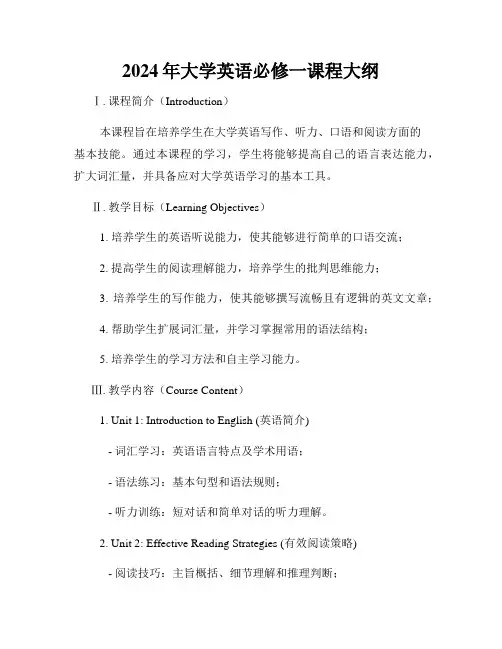
2024年大学英语必修一课程大纲Ⅰ. 课程简介(Introduction)本课程旨在培养学生在大学英语写作、听力、口语和阅读方面的基本技能。
通过本课程的学习,学生将能够提高自己的语言表达能力,扩大词汇量,并具备应对大学英语学习的基本工具。
Ⅱ. 教学目标(Learning Objectives)1. 培养学生的英语听说能力,使其能够进行简单的口语交流;2. 提高学生的阅读理解能力,培养学生的批判思维能力;3. 培养学生的写作能力,使其能够撰写流畅且有逻辑的英文文章;4. 帮助学生扩展词汇量,并学习掌握常用的语法结构;5. 培养学生的学习方法和自主学习能力。
Ⅲ. 教学内容(Course Content)1. Unit 1: Introduction to English (英语简介)- 词汇学习:英语语言特点及学术用语;- 语法练习:基本句型和语法规则;- 听力训练:短对话和简单对话的听力理解。
2. Unit 2: Effective Reading Strategies (有效阅读策略)- 阅读技巧:主旨概括、细节理解和推理判断;- 阅读材料:新闻报道、学术论文和文学作品等;- 阅读训练:阅读材料的理解和分析。
3. Unit 3: Oral Communication (口语交际)- 口语表达:日常用语、问答技巧和辩论技巧;- 口语训练:模拟对话、小组讨论和演讲练习;- 听力训练:听取口语材料并作出回应。
4. Unit 4: Academic Writing Skills (学术写作技巧)- 写作技巧:写作结构、段落发展和逻辑连接;- 写作训练:学术文章写作和写作练习;- 语法练习:句子结构和语法错误的修正。
5. Unit 5: Vocabulary Expansion (词汇扩展)- 词汇学习:学习常用词汇、词根和词缀;- 词汇应用:词汇拓展和语境运用练习。
Ⅳ. 教学方法(Teaching Methods)本课程采用综合教学方法,包括课堂讲授、小组讨论、听力练习、口语训练、写作练习和课外阅读等。
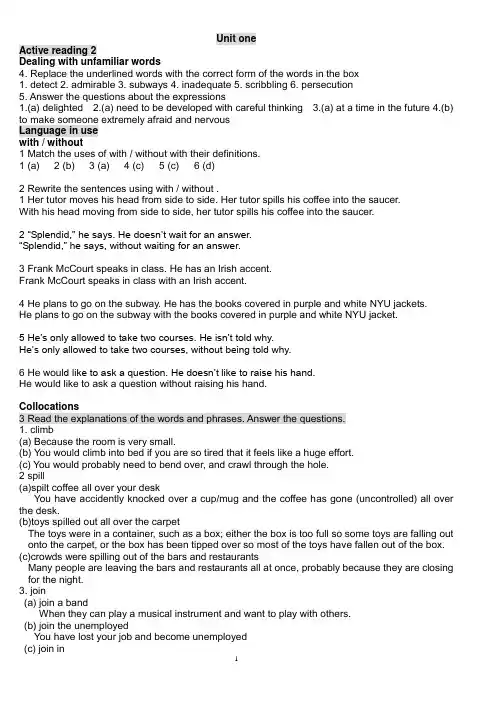
Unit oneActive reading 2Dealing with unfamiliar words4. Replace the underlined words with the correct form of the words in the box1. detect2. admirable3. subways4. inadequate5. scribbling6. persecution5. Answer the questions about the expressions1.(a) delighted2.(a) need to be developed with careful thinking3.(a) at a time in the future4.(b) to make someone extremely afraid and nervousLanguage in usewith / without1 Match the uses of with / without with their definitions.1 (a)2 (b)3 (a)4 (c)5 (c)6 (d)2 Rewrite the sentences using with / without .1 Her tutor moves his head from side to side. Her tutor spills his coffee into the saucer.With his head moving from side to side, her tutor spills his coffee into the saucer.2 “Splendid,” he says. He doesn’t wait for an answer.“Splendid,” he says, without waiting for an answer.3 Frank McCourt speaks in class. He has an Irish accent.Frank McCourt speaks in class with an Irish accent.4 He plans to go on the subway. He has the books covered in purple and white NYU jackets.He plans to go on the subway with the books covered in purple and white NYU jacket.5 He’s only allowed to take two courses. He isn’t told why.He’s only allowed to take two courses, without being told why.6 He wou ld like to ask a question. He doesn’t like to raise his hand.He would like to ask a question without raising his hand.Collocations3 Read the explanations of the words and phrases. Answer the questions.1. climb(a) Because the room is very small.(b) You would climb into bed if you are so tired that it feels like a huge effort.(c) You would probably need to bend over, and crawl through the hole.2 spill(a)spilt coffee all over your deskYou have accidently knocked over a cup/mug and the coffee has gone (uncontrolled) all over the desk.(b)toys spilled out all over the carpetThe toys were in a container, such as a box; either the box is too full so some toys are falling out onto the carpet, or the box has been tipped over so most of the toys have fallen out of the box.(c)crowds were spilling out of the bars and restaurantsMany people are leaving the bars and restaurants all at once, probably because they are closing for the night.3. join(a) join a bandWhen they can play a musical instrument and want to play with others.(b) join the unemployedYou have lost your job and become unemployed(c) join inYou do the same activity that most other people are doing.4 burst into(a) burst into tearsThe writer suddenly started crying.(b) bursts into bloomFlowers, when they suddenly emerge from buds.(c) burst into flames.Put out the flames immediately if you can, or keep well clear and call the emergency services (fire brigade)5 clean(a) a clean licenceThis refers to a driving licence. It means that you have been driving safely or at least you have no penalty points on the licence ---a person gets such points as a punishment after breaking the law on the roads eg speeding or causing an accident, and the licence then has a note on it (it’s not “clean”) and the police have a record.(b) clean languageYou avoid using swear words or other examples of bad language.(c) a clean bill of healthHere this phrase is used metaphorically and means something is working properly, for example, a car might have “a clean bill of health” after a check or test it is working correctly.6 easy(a) easy-goingAn easy-going person behaves, in a relaxed, calm manner with others and is happy to accept things without getting worried or angry.(b) easy on the eyeA person who is easy on the eye is pleasant to look at in appearance and in the way theydress.(c) easier said than doneWhen something is easier said than done, it is easy to talk about, but difficult to achieve. (d) take it easyWhen they tell you to “Take it easy” they can mean either of two things: You should rest and not do things that will make you tired, or you should keep calm, being less upset or angry.4. Complete the sentence using the collocations in Activity 31 spill out of2 burst into tears3 clean language4 easier5 climb through6 spilt7 join in8 burst into bloom9 clean licence 10 easy on the eye5 Translate the sentences into Chinese.1. Finally, with my mother red in the face and short of breath, we find Room 8, I unlock the door,and we all walk in.(☞介词with 表示状态,不必直译。
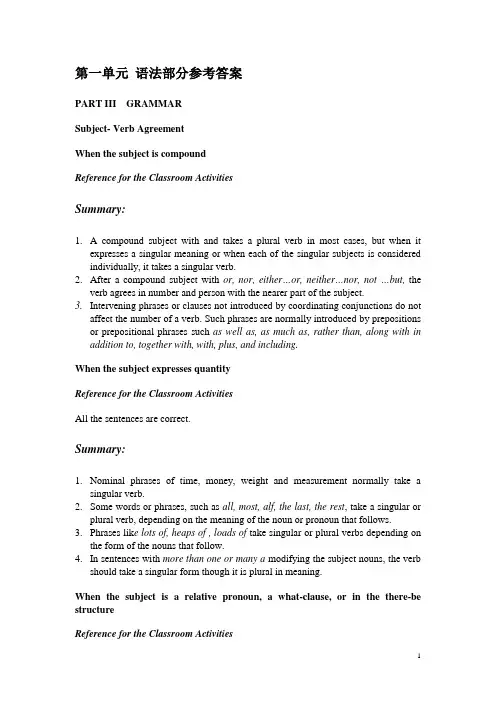
第一单元语法部分参考答案PART III GRAMMARSubject- Verb AgreementWhen the subject is compoundReference for the Classroom ActivitiesSummary:1. A compound subject with and takes a plural verb in most cases, but when itexpresses a singular meaning or when each of the singular subjects is considered individually, it takes a singular verb.2.After a compound subject with or, nor, either…or, neither…nor, not …but,theverb agrees in number and person with the nearer part of the subject.3.Intervening phrases or clauses not introduced by coordinating conjunctions do notaffect the number of a verb. Such phrases are normally introduced by prepositions or prepositional phrases such as well as, as much as, rather than, along with in addition to, together with, with, plus, and including.When the subject expresses quantityReference for the Classroom ActivitiesAll the sentences are correct.Summary:1.Nominal phrases of time, money, weight and measurement normally take asingular verb.2.Some words or phrases, such as all, most, alf, the last, the rest, take a singular orplural verb, depending on the meaning of the noun or pronoun that follows.3.Phrases lik e lots of, heaps of , loads of take singular or plural verbs depending onthe form of the nouns that follow.4.In sentences with more than one or many a modifying the subject nouns, the verbshould take a singular form though it is plural in meaning.When the subject is a relative pronoun, a what-clause, or in the there-be structureReference for the Classroom Activitiesa. He was one of the candidates who were able to carry out their campaign pledges.He was the only one of the candidates who was able to carry out his campaign pledgesb. What he wants is just a little love from his foster parents.What one thinks and says are not always the same.c. There is a cherry tree and several orchid flowers in the garden.There are hundreds of applicants on the waiting list for the job.Summary:1.After a relative pronoun (who, which, that), the verb has the same person andnumber as the antecedent. (In the second sentence in Pair a, the antecedent is the only one, not the candidates.)2.After a what-clause, the verb is usually singular,. But if the what-clause is in acompound structure plural in meaning, the verb is in plural form.3.In the there-be structure, the verb is singular or plural depending on the number ofthe subject. The singular there is may be used to introduce a compound subject when the first noun or nominal phrase is singular.OthersReference for the Classroom Activitiesa. Nobody in town admits seeing him.b. Does anyone want to go with me?c. Are any of you going to the exhibition?d. None works/work so hard as he does.e. Books are her chief source of enjoyment.f. The one thing you must be ready for is their attempts to break up the meetingg. The jury is finally complete.h. The jury were divided in their Opinions.i. New York Times is his bible.j. Semantics is the study of meanings.Summary:1.Indefinite pronouns such as anybody, anyone, each, everybody, nobody, no one,and somebody generally require a singular verb.2.The pronouns any and none take either singular or plural verbs.3.The complement of the verb be does not affect its number.4. A collective noun takes a singular verb when the class it names is thought of as aunit, but a plural verb when the members of the class are thought of as individuals.5.Titles of books, magazines, movies, newspapers, plays, and the like take asingular verb.6.Certain nouns which are plural in form but singular in meaning generally take asingular verb. Some of these are physics, mechanics, news, statistics,and whereabouts.PART V FOLLOW-UP EXERCISES1. a. The little boy was chicken-hearted.b. That statesman is a respectable figure in the political arena.c. We sat down by the oak tree, enjoying the breeze coming from the laked. We need to drink the milk before it sours.e. The child had difficulty finding his way to school.f. The young woman received a lot of flowers and gifts.g. My father drew back the curtain a little lest I see him.h. Our university can accommodate 4,000 students.i. Social custom s vary greatly from country to country.2. The writer's attitude changes from negative to positive in each pair of sentences3. (1)experienced (2) elapsed(3)attempting (4) with(5)take up (6) made(7)endeavor (8) true4. a. The state attorney said that the man would be prosecuted.b. We suppose that a referee should be disinterested but not uninterestedc. Tony can hit a ball farther than I can.d. We must pursue this matter further.e. The principles behind our constitution are a principal reason for its astounding success.f. Al1 the band instruments except the tuba will be carried to the auditorium for the music contest.g. The federal government comprises the legislative, judicial, and executive branchesh. The whole region was struck by an economic disaster.i. (correct)j. He was awaked to the risk.5. My sister Lulu accepted a scholarship to study in the UK. She had done very well in school and the principal thought that living with a British family would teach her a lot. Mother said she would let her go if she bought a box of stationery and promised to write home every week. She said that she would live up to her promise and she always does pretty well in living up to her principles. Soon after she arrived in the UK., she adapted to her new environment. Her new life did not affect her a great deal. She knew that as a student she had to be economical and she was not self-conscious of her poor clothing and strange accent. These were the things she was uninterested in; what fascinated her instead was the cultural differences between the two countries. She found people there liked to pay compliments and were more credulous to what she said. Of course, she never lied to them about her motherland. Though she experienced cultural shocks continually, she developed a fair attitude towards the other culture. In the proceeding years, she settled down in the UK. and became a person with an alternative cultural identity.6. a. Sixty hours is the amount of work time I contracted for.b. The jury is expected to reach its decision very quickly.c. Each of the candidates for the position has exceptionally high qualifications.d. Every boy and girl in the sixth grade was/is eager to win the contest.e. Corn bread and milk is a popular breakfast in the rural South.f. The instructor as well as the students was at fault.g. He is one of the students who plan to attend the speech contest.h. The jury are to be isolated in individual hotel rooms each night during the triali. Sam sprawled in the chair and knocked over one of the lamps which were on displayj. The symptoms of mercury poisoning vary with each individual case.k. He believes that athletics improves school morale.l. Up goes the starter's gun, and each of the runners becomes tense.m. Either The Times or The Tribune is a reliable source of news.n. The first thing that catches your eye is the headlines.o. She is one of the women who have made this country what it is.。
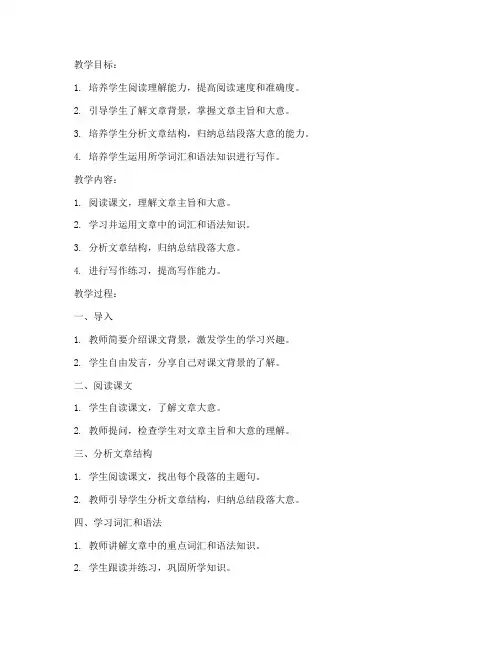
教学目标:1. 培养学生阅读理解能力,提高阅读速度和准确度。
2. 引导学生了解文章背景,掌握文章主旨和大意。
3. 培养学生分析文章结构,归纳总结段落大意的能力。
4. 培养学生运用所学词汇和语法知识进行写作。
教学内容:1. 阅读课文,理解文章主旨和大意。
2. 学习并运用文章中的词汇和语法知识。
3. 分析文章结构,归纳总结段落大意。
4. 进行写作练习,提高写作能力。
教学过程:一、导入1. 教师简要介绍课文背景,激发学生的学习兴趣。
2. 学生自由发言,分享自己对课文背景的了解。
二、阅读课文1. 学生自读课文,了解文章大意。
2. 教师提问,检查学生对文章主旨和大意的理解。
三、分析文章结构1. 学生阅读课文,找出每个段落的主题句。
2. 教师引导学生分析文章结构,归纳总结段落大意。
四、学习词汇和语法1. 教师讲解文章中的重点词汇和语法知识。
2. 学生跟读并练习,巩固所学知识。
五、写作练习1. 教师给出写作题目,要求学生运用所学知识进行写作。
2. 学生独立完成写作,教师巡视指导。
六、课堂小结1. 教师总结本节课所学内容,强调重点和难点。
2. 学生回顾所学知识,提出疑问。
七、课后作业1. 复习课文,掌握文章主旨和大意。
2. 预习下一课,为下一节课做好准备。
教学评价:1. 课堂表现:观察学生在课堂上的发言、互动情况,评价其学习态度和参与度。
2. 阅读理解:通过提问、讨论等方式,评价学生对文章主旨和大意的理解程度。
3. 词汇和语法:通过学生的跟读、练习,评价其对词汇和语法知识的掌握程度。
4. 写作能力:通过学生的写作练习,评价其写作能力。
教学反思:1. 本节课是否达到了教学目标?2. 学生在课堂上的表现如何?3. 教学方法是否合适?4. 如何改进教学效果?备注:1. 教师应根据学生的实际情况调整教学内容和进度。
2. 注重培养学生的阅读兴趣和自主学习能力。
3. 鼓励学生积极参与课堂活动,提高课堂氛围。
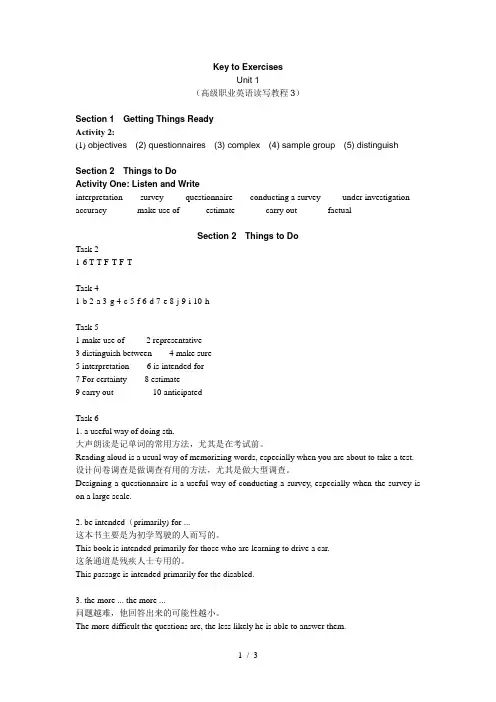
Key to ExercisesUnit 1(高级职业英语读写教程3)Section 1 Getting Things ReadyActivity 2:(1)objectives (2) questionnaires (3) complex (4) sample group (5) distinguishSection 2 Things to DoActivity One: Listen and Writeinterpretation survey questionnaire conducting a survey under investigation accuracy make use of estimate carry out factualSection 2 Things to DoTask 21-6 T-T-F-T-F-TTask 41-b 2-a 3-g 4-c 5-f 6-d 7-e 8-j 9-i 10-hTask 51 make use of2 representative3 distinguish between4 make sure5 interpretation6 is intended for7 For certainty 8 estimate9 carry out 10 anticipatedTask 61. a useful way of doing sth.大声朗读是记单词的常用方法,尤其是在考试前。
Reading aloud is a usual way of memorizing words, especially when you are about to take a test. 设计问卷调查是做调查有用的方法,尤其是做大型调查。
Designing a questionnaire is a useful way of conducting a survey, especially when the survey is on a large scale.2. be intended(primarily) for ...这本书主要是为初学驾驶的人而写的。
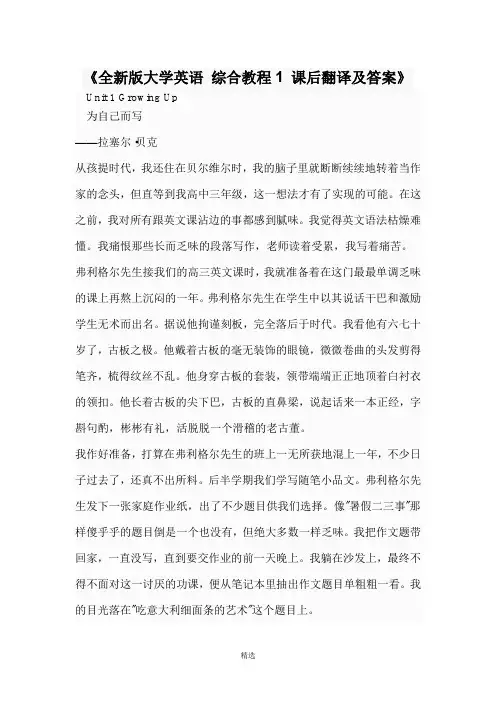
《全新版大学英语综合教程1 课后翻译及答案》Unit 1 Growing Up为自己而写——拉塞尔·贝克从孩提时代,我还住在贝尔维尔时,我的脑子里就断断续续地转着当作家的念头,但直等到我高中三年级,这一想法才有了实现的可能。
在这之前,我对所有跟英文课沾边的事都感到腻味。
我觉得英文语法枯燥难懂。
我痛恨那些长而乏味的段落写作,老师读着受累,我写着痛苦。
弗利格尔先生接我们的高三英文课时,我就准备着在这门最最单调乏味的课上再熬上沉闷的一年。
弗利格尔先生在学生中以其说话干巴和激励学生无术而出名。
据说他拘谨刻板,完全落后于时代。
我看他有六七十岁了,古板之极。
他戴着古板的毫无装饰的眼镜,微微卷曲的头发剪得笔齐,梳得纹丝不乱。
他身穿古板的套装,领带端端正正地顶着白衬衣的领扣。
他长着古板的尖下巴,古板的直鼻梁,说起话来一本正经,字斟句酌,彬彬有礼,活脱脱一个滑稽的老古董。
我作好准备,打算在弗利格尔先生的班上一无所获地混上一年,不少日子过去了,还真不出所料。
后半学期我们学写随笔小品文。
弗利格尔先生发下一张家庭作业纸,出了不少题目供我们选择。
像"暑假二三事"那样傻乎乎的题目倒是一个也没有,但绝大多数一样乏味。
我把作文题带回家,一直没写,直到要交作业的前一天晚上。
我躺在沙发上,最终不得不面对这一讨厌的功课,便从笔记本里抽出作文题目单粗粗一看。
我的目光落在"吃意大利细面条的艺术"这个题目上。
这个题目在我脑海里唤起了一连串不同寻常的图像。
贝尔维尔之夜的清晰的回忆如潮水一般涌来,当时,我们大家一起围坐在晚餐桌旁——艾伦舅舅、我母亲、查理舅舅、多丽丝、哈尔舅舅——帕特舅妈晚饭做的是意大利细面条。
那时意大利细面条还是很少听说的异国食品。
多丽丝和我都还从来没吃过,在座的大人也是经验不足,没有一个吃起来得心应手的。
艾伦舅舅家诙谐有趣的场景全都重现在我的脑海中,我回想起来,当晚我们笑作一团,争论着该如何地把面条从盘子上送到嘴里才算合乎礼仪。
![全新版大学英语综合教程(第二版)第一册_课文翻译与课后答案[1]](https://uimg.taocdn.com/0f4ac8f7e53a580216fcfecb.webp)
Unit 1 Growing Up为自己而写——拉塞尔·贝克从孩提时代,我还住在贝尔维尔时,我的脑子里就断断续续地转着当作家的念头,但直等到我高中三年级,这一想法才有了实现的可能。
在这之前,我对所有跟英文课沾边的事都感到腻味。
我觉得英文语法枯燥难懂。
我痛恨那些长而乏味的段落写作,老师读着受累,我写着痛苦。
弗利格尔先生接我们的高三英文课时,我就准备着在这门最最单调乏味的课上再熬上沉闷的一年。
弗利格尔先生在学生中以其说话干巴和激励学生无术而出名。
据说他拘谨刻板,完全落后于时代。
我看他有六七十岁了,古板之极。
他戴着古板的毫无装饰的眼镜,微微卷曲的头发剪得笔齐,梳得纹丝不乱。
他身穿古板的套装,领带端端正正地顶着白衬衣的领扣。
他长着古板的尖下巴,古板的直鼻梁,说起话来一本正经,字斟句酌,彬彬有礼,活脱脱一个滑稽的老古董。
我作好准备,打算在弗利格尔先生的班上一无所获地混上一年,不少日子过去了,还真不出所料。
后半学期我们学写随笔小品文。
弗利格尔先生发下一张家庭作业纸,出了不少题目供我们选择。
像"暑假二三事"那样傻乎乎的题目倒是一个也没有,但绝大多数一样乏味。
我把作文题带回家,一直没写,直到要交作业的前一天晚上。
我躺在沙发上,最终不得不面对这一讨厌的功课,便从笔记本里抽出作文题目单粗粗一看。
我的目光落在"吃意大利细面条的艺术"这个题目上。
这个题目在我脑海里唤起了一连串不同寻常的图像。
贝尔维尔之夜的清晰的回忆如潮水一般涌来,当时,我们大家一起围坐在晚餐桌旁——艾伦舅舅、我母亲、查理舅舅、多丽丝、哈尔舅舅——帕特舅妈晚饭做的是意大利细面条。
那时意大利细面条还是很少听说的异国食品。
多丽丝和我都还从来没吃过,在座的大人也是经验不足,没有一个吃起来得心应手的。
艾伦舅舅家诙谐有趣的场景全都重现在我的脑海中,我回想起来,当晚我们笑作一团,争论着该如何地把面条从盘子上送到嘴里才算合乎礼仪。
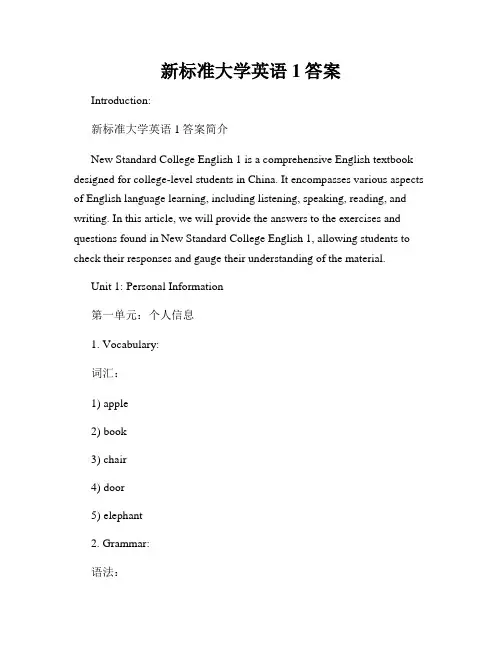
新标准大学英语1答案Introduction:新标准大学英语1答案简介New Standard College English 1 is a comprehensive English textbook designed for college-level students in China. It encompasses various aspects of English language learning, including listening, speaking, reading, and writing. In this article, we will provide the answers to the exercises and questions found in New Standard College English 1, allowing students to check their responses and gauge their understanding of the material.Unit 1: Personal Information第一单元:个人信息1. Vocabulary:词汇:1) apple2) book3) chair4) door5) elephant2. Grammar:语法:1) He is a student.2) She is my sister.3) They are teachers.4) We are friends.5) I am an engineer.3. Listening:听力:1) B2) A3) C4) B5) CUnit 2: Daily Life第二单元:日常生活1. Vocabulary:词汇:1) breakfast2) lunch3) dinner5) vegetables2. Grammar:语法:1) I wake up at 7:00 am every day.2) She brushes her teeth before going to bed.3) They have lunch at 12:30 pm.4) We go to the gym in the evening.5) He reads a book before sleeping.3. Listening:听力:1) C2) B3) A4) A5) BUnit 3: Leisure Activities第三单元:休闲活动1. Vocabulary:1) swimming2) dancing3) painting4) hiking5) cooking2. Grammar:语法:1) She enjoys swimming in the pool.2) They like dancing at parties.3) He loves painting landscapes.4) We go hiking in the mountains.5) I enjoy cooking Italian cuisine. 3. Listening:听力:1) B2) C3) A4) BUnit 4: Travel第四单元:旅行1. Vocabulary:词汇:1) airplane2) hotel3) passport4) suitcase5) destination2. Grammar:语法:1) I am going to Europe next month.2) She will stay at a five-star hotel.3) They have their passports ready.4) We need to pack our suitcases.5) He is excited to explore a new destination.3. Listening:听力:2) A3) B4) B5) AConclusion:结论This article has provided the answers to exercises and questions found in the first four units of New Standard College English 1. By referring to this article, students can check their responses and assess their progress in learning English. Remember to practice regularly and utilize the accompanying materials provided by the textbook to further enhance your language skills. Good luck with your English language learning journey!。
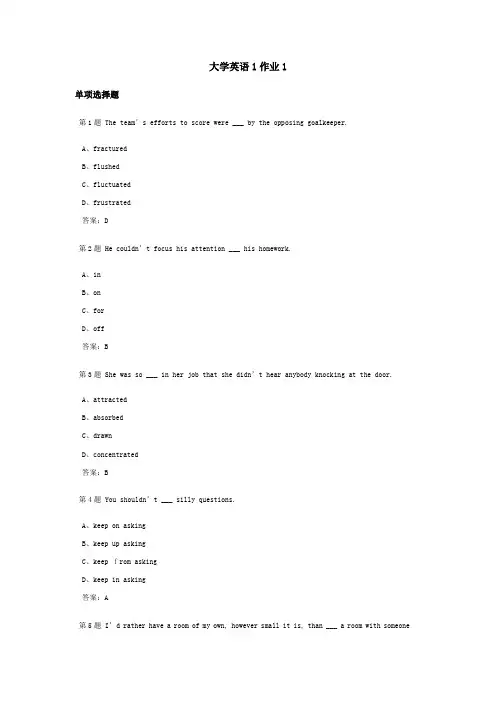
大学英语1作业1单项选择题第1题The team’s efforts to score were ___ by the opposing goalkeeper.A、fracturedB、flushedC、fluctuatedD、frustrated答案:D第2题He couldn’t focus his attention ___ his homework.A、inB、onC、forD、off答案:B第3题She was so ___ in her job that she didn’t hear anybody knocking at the door.A、attractedB、absorbedC、drawnD、concentrated答案:B第4题You shouldn’t ___ silly questions.A、keep on askingB、keep up askingC、keep from askingD、keep in asking答案:A第5题I’d rather have a room of my own, however small it is, than ___ a room with someoneelse.A、to shareB、to have sharedC、shareD、sharing答案:C第6题The government are committed ___ the cause of improving the people’s living standard.A、toB、ofC、forD、away答案:A第7题The two friends haven’t ___ with each other for 20 years.A、associatedB、communicatedC、been acquainted withD、been along with答案:B第8题it’s ___ that the sick child needs fo od and sunshine.A、consciousB、obviousC、consistentD、plain答案:B第9题When I was making a list of guests for the party, her name didn’t ___ to me.A、existB、happenC、occurD、ake place答案:C第10题The committee’s suggestions w ill be ___ immediately.A、implementedB、complementedC、supplementedD、complimented答案:A第11题 the customers made some ___ about the high prices and low quality of their products.A、fussB、adoC、complaintD、explanation答案:C第12题 He ___ me to accept their compromise which made me extraordinarily angry.A、urgedB、appealedC、drawD、asked答案:A第13题 John is ___ to visit her because they have completely different political views.A、likelyB、reluctantC、keenD、eager答案:B第14题 The people were ___ to do their best to save their nation.A、urgedB、amazedC、forcedD、asked答案:A第15题 One of his attributes is his ability to ___ to different working conditions.A、adoptB、adeptC、admitD、adapt答案:D第16题from the 17th century on, the progress of scientific discovery proceeded at an ever-increasing ___.A、paceB、turnC、velocityD、rate答案:A第17题 Unfortunately, Ms. Black was not ___ of the problems that were discovered finally by her boss.A、concernedB、awareC、interstedD、dependent答案:B第18题 It is necessary that an efficient worker ___ his work on time.A、accomplishesB、accomplishedC、accomplishD、has accomplished答案:C第19题 I decided to put my watch under my pillow ___ someone tried to steal it at night.A、in no caseB、in any caseC、in the case ofD、in case答案:D第20题 We can expect ___ more mosquitoes after the continued falls of rain.A、a fewB、a littleC、fewD、little答案:A。
Welcome UnitI. 语法填空1. ______ a senior high school newcomer _______is not outgoing, I’ma little anxious right now. I wonder if I can make a good first ____________ (impress), and make any friends _______ can talk to me.2.___________ my first maths class at senior high school was difficult, the teacher was kind and friendly. He even told us a__________ (fun) story, __________ made us burst into ___________ (laugh). To my joy, my classmates and teachers were friendly and __________ (help).3. I believ e there’s a lot _____________ (explore) at senior high and tomorrow will be a great day, I feel much more _____________ (confidence) than I felt this morning.4. Ann Wells is ______ Grade 10 student at Lakeside High School,__________ plan is to become _________ engineer in the future.5. You'll never Thando Gowon, a hard-working student from South Hill High School _________ a book or a pen. With a dream is to start his own IT company, he is always busy _________ (study)II. 句子考查1. “ Will I make any friends? What if no one talks to me?”(改写)I have no idea_________ ______ ______ make any friend and what I should do if no onetalks to me.2. I couldn’t concentrate on the experiment. The guy next to me tried to talk to me the whole time. And this is the reason (句子合并)The reason ________I couldn’t concentrate on theexperiment_______ that the guy next to me tried to talk to me the whole time.3. I’m a student curious about everything. I often ask questions. I learn best by doing. (合并为含让步从句和定语从句的复合句)_______ I am a student ________ is curious about everything and often ask questions, I learn best by doing.4. If I'm not in class, you can find me in the library and you can find me in the computer lab.(改写)If I'm not in class, I’m__________ in the library______ in the computer lab.Unit1Teenage lifeI. 语法填空1. To a freshman at senior high school, the first week was a little ____________ (confuse).And he finds ______ hard to decide which courses to take.2. Though he knows_________ Chinese is a very difficult language, he hopes to be fluent _____ he graduates.3. His adviser recommended ________he should sign up _______ advanced literature because I like English _______ I’m good at it.4._______a senior high school student, I know I’ll have to study harder and get used to _______ responsible for a lot more. I’m a bit worried about _________ (keep) up with the other students in my ___________(advance) course, ________ it’ll be quite difficult to get used t o all the homework.5. Studying hard isn’t always fun, _______ I’ll be well___________(prepare) for university or ____________(what) else comes in the future.6. But___________ (spend) too much time online is unhealthy and make______ very difficult to focus on other things in life.II. 句子考查1. The extra-curricular activities coach told him that he didn’t play well enough. Obviously, he was unhappy. (改写为复合句)It was __________ _______ he was unhappy when the coach told him that he didn’t play well.2. I’ll find a way to improve on my own so that I can make the team next year.(改为简单句)______ ______ _______ make the team next year, I will find a way to improve my own.3. Your generation are attracted to computer games and on the online world. (用it 和usual改为双重否定句)_______ _______ _______ _______ for your generation to be attracted to computer games and the online world.4. Some students become addicted to the Internet. They cannotconcentrate on school andfamily life.(用定语从句改写)_______ _______ _______ some students cannot concentrate onschool and family life______ ________ they become addicted to the Internet.Unit 2 Travelling aroundI. 语法填空1. PERU is a country on the Pacific coast of South America ________ three main areas. narrow, dry, flat land____________(run) along the coast, the Andes Mountains, _______ the Amazon rainforest.2. Ancient Inca Empire, __________emperor lived in the now-famous site Machu Picchu, was powerful in the 1400s and 1500s.3. You can then spend three days _____________ (explore) the rainforest _________ a local guide and enjoying the plants and animalsunique _________ the rainforest.4. After ___________(reach) your destination, you will have a day to explore and ________ (amaze) by this ancient city.5. Inca builders cut stones to exact sizes ______ ______ nothing was needed to hold walls together other than the perfect fit of the stones.6. Enjoy the beautiful countryside ______you spend a day ________ (drive) along the new highway ___________ (connect) Cusco to Lake Titicaca.7. To me, the story of the Terracotta Army is almost ________________ (believe) amazing.II. 句子理解1. Spain took control of Peru in the 16th century and ruled until 1821 and Spanish is the main official language of Peru for this reason.(把第二个并列句改为强调句)Spain took control of Peru in the 16th century and ruled until 1821 and______ _____________this reason ________ Spanish is the main official language of Peru.2. T here are more than 8,000 statues. It is amazing. And no one in moderntimes knew about them until the 1970s (合并成含主语从句的并列复合句)_______ _______ amazing _________ there are more that 8,000 statues, ________ no one in modern times knew about them until the 1970. (另:The reason for which...is tha)3. Each statue has a different face, leading researchers to believe that each one is a copy of a real soldier. (用定语从句改写)Each statue has a different face, _________ leads researchers to believe that each one is a copy.4. The statues fill only one part of the emperor’s huge tomb. The tomb still has not been completely unearthed. (用定语从句合并)___________________________________________________________ ___________________________________________________________ _________________________________Unit 3 Sports and fitnessI. 语法填空1. Lang Ping, the famous coach, ____________(face) a big challenge when the Chinese team______________ (prepare) for the 2015 World Cup.2. As one of the best players_______________(injure), and the team captain had to leave because of heart problems, theteam_________ Lang Ping had built was falling apart.3. Having faced _____________(difficult) before, she didn’t lose heart but work harder.4. The young players,_________(lead) by Lang Ping, worked as a team and won the honor of being the world champions in 2015__________the fact that they had lost two important players.5. Known ______ “Air Jordan”, Jordan changed basketball _______ his graceful moves and jumps.6. Jordan, whose skills were ____________(impress), showed great mental strength_______ made him unique.7. Jordan, __________ secret to success is learning from his failures, always seemed to find a way to win.8. By________ positive about myself and my body, I became both happier and _______ (health).9. You must wear school uniforms at school, ___________________ ?Yes, we _________./ No, we __________(don’t have to).II. 句子理解1. The Boys and Girls Club has been helping young people since 1996. He the club started in Chicago.(用定语从句合并)________________________________________________________ ________________________________________________________ __________________________________2. 梦想长得像在电视上的苗条女孩,我担心我的体重,尝试了我在网上读到的每一种新的饮食。
全新版大学英语视听说教程2答案 unit1一、Unit1听力部分答案1、短对话听力答案1)答案:C。
在对话中,女士提到自己的丈夫在开车时总是听新闻,但男士说他不认为这是一种好的驾驶习惯,因为这会使他分心。
因此,正确答案是C,即“听新闻不是好的驾驶习惯”。
2)答案:A。
在对话中,女士提到她需要一份工作来支付她的学费,而男士问她是否考虑过当老师,因为教师有暑假和寒假,这可以让她有更多的时间来完成学业。
因此,正确答案是A,即“考虑当老师”。
3)答案:B。
在对话中,女士提到她需要一份工作来支付她的学费,而男士问她是否考虑过当老师,因为教师有暑假和寒假,这可以让她有更多的时间来完成学业。
因此,正确答案是B,即“考虑当老师”。
4)答案:D。
在对话中,女士提到她想成为一名律师,因为她喜欢法律和辩论。
但是男士告诉她,这个职业并不容易,需要大量的学习和工作。
因此,正确答案是D,即“成为一名律师不容易”。
5)答案:A。
在对话中,女士提到她想成为一名律师,因为她喜欢法律和辩论。
但是男士告诉她,这个职业并不容易,需要大量的学习和工作。
因此,正确答案是A,即“成为一名律师不容易”。
2、长对话听力答案1)答案:A。
在对话中,女士提到自己最喜欢的颜色是红色,因为红色能激发她的热情和动力。
因此,正确答案是A,即“红色能激发她的热情和动力”。
2)答案:B。
在对话中,女士提到自己最喜欢的颜色是红色,因为红色能激发她的热情和动力。
因此,正确答案是B,即“红色能激发她的热情和动力”。
3)答案:C。
在对话中,女士提到自己最喜欢的颜色是红色,因为红色能激发她的热情和动力。
因此,正确答案是C,即“红色能激发她的热情和动力”。
4)答案:D。
在对话中,女士提到自己最喜欢的颜色是红色,因为红色能激发她的热情和动力。
因此,正确答案是D,即“红色能激发她的热情和动力”。
5)答案:A。
在对话中,女士提到自己最喜欢的颜色是红色,因为红色能激发她的热情和动力。
语法讲解:some、any、复合不定代词一、some 和any1.some和any既可以修饰可数名词又可以修饰不可数名词,some常用在肯定句中,而any 则常用在否定句和疑问句中,如:(1) --- I have some tea here. 我这儿有些茶叶。
(2) --- I can't see any tea. 我没看见茶叶。
(3) Do you have any friends at school? 你在学校有朋友吗?2.Some也可以用在疑问句中,表示希望得到肯定的回答,如。
Would you like some cold water to drink? 你想要喝一些冷水吗?二、复合不定代词复合不定代词由some, any, no加body, thing 或one 构成,用来指代不特定的人或物。
具体来说:(1) 复合不定代词someone/somebody表示“某人”,something表示“某物”,它们常用于肯定句中。
也可以用在疑问句中,表示希望得到肯定的回答。
如:There is somebody/someone in the room. 房间里有人。
Would you like something to eat? 你想吃点什么吗?(2) 复合不定代词anyone/anybody表示“某人;任何人”,anything表示“某物;任何事物”,它们常用于否定句或疑问句中。
如:There isn’t anything in the house. 屋子里没有任何东西。
Did you see anyone/anybody there? 你在那儿看到什么人了吗?(3) 复合不定代词no one/nobody表示“没有人”,相当于not anyone/anybody ,nothing 表示“没什么东西”,相当于not anything 。
如:I saw nobody there. 我在那儿谁也没看到。
《新编英语语法教程》主要章节语法术语Introduction: Grammatical Hierarchy (导论—语法层次)2. Parts of speech (word class)3. Phrases词组4. Clause分句5. Sentence句子1. Morpheme词素Free morpheme 自由词素Bound morpheme 粘附词素Allomorph 词素变体Noun phraseVerb phraseAdjective phraseAdverb phrasePreposition phraseConjunctionLecture 1 Sentence Structure(L1)Sentence elements:S (subject) 主语V (predicate verb)谓语动词O (object)宾语C (complement)补足语A (Adverbial)状语1. Two ways of sentence analysis1) SVOSentenceClauseNP VP NPSubject Predicate verb ObjectAll the man have done their best.Sentence = Subject + Predicate (Predicate Verb + Object, Complement, Adverbial, etc.)●句子由主语和谓语构成,进一步把谓语剖析为谓语动词、宾语、补语、状语等。
2) Subject + Predicate (= operator + predication)SentenceClauseSubject PredicateOperator PredicationAll the man have done their best.●句子由主语和谓语构成,进一步把谓语剖析为操作词(operator)和述谓成分(predication)。
大学英语综合教程(中职英语)Unit 1 college life【语法:名词】练习答案1.The storm has caused______to this region.A.many damages B.much damagesC.much damage D.few damages【答案】C【解析】damage是不可数名词。
【译文】暴风雨给这个地区造成了很大的破坏2.Our family ______ not to exchange gifts this year.A.has agreed B.have agreed C.agrees D.had agreed 【答案】B【解析】family 是个集体名词,但在不同的语境下游集体与个体之分。
此题突出家庭每个成员的个体,相互赠礼。
作为整体时用单数,强调集体概念。
【译文】我们家同意今年不交换礼物。
3.Good food,not _________,that’s how one gets fat. A.enough exercises B.exercises enoughC.enough exercise D.exercise enough【答案】C【解析】enough修饰名词时只能放在其修饰的名词前,而修饰形容词时要放在其后。
exercise作不可数名词时为“训练”。
【译文】食物好,锻炼少,这就是一个人长胖的原因。
4.The news of victory____spreading far and wide.A.areB.isC.have beenD. were【答案】B【解析】主语是news,是不可数名词,谓语动词用单数。
【译文】胜利的消息传遍四面八方。
5.All the____in this hospital will get a rise tomorrow.A. women-doctorB. woman doctorsC. women doctorsD. doctors of women【答案】C【解析】该题是语法题,考查合成名词的复数形式。
新课程大学英语教材答案第一单元:课程介绍新课程大学英语教材答案是为了帮助学生更好地学习英语而编写的辅助资料。
本教材答案覆盖了新课程大学英语教材中的各个单元和课文内容,旨在让学生更好地理解和掌握所学知识,并能够通过自主学习提高英语水平。
第二单元:听力练习答案听力练习是新课程大学英语教学中重要的一环。
通过听力练习,学生可以提高自己的听力技巧和理解能力。
下面是新课程大学英语教材中第一单元至第十单元的听力练习参考答案:Unit 1:1. B2. C3. A4. B5. AUnit 2:1. C2. A4. A5. C......(此处省略了第三单元至第九单元的答案,为后续单元留出空间)第十单元:1. A2. C3. B4. A5. B第三单元:阅读练习答案阅读练习是提高英语阅读理解能力的重要途径。
新课程大学英语教材中的阅读练习涵盖了各个主题,通过阅读不同类型的文章,学生可以扩大自己的词汇量并提高阅读速度和理解能力。
下面是新课程大学英语教材中第一单元至第十单元的阅读练习参考答案:Unit 1:1. C2. A4. D5. CUnit 2:1. B2. C3. A4. D5. B......(此处省略了第三单元至第九单元的答案,为后续单元留出空间)第十单元:1. A2. D3. B4. C5. A第四单元:语法练习答案语法是学习一门外语的重要基础。
新课程大学英语教材中的语法练习旨在帮助学生巩固和运用所学的语法知识。
下面是新课程大学英语教材中第一单元至第十单元的语法练习参考答案:Unit 1:1. will study2. don't like3. is listening4. Are you going5. have livedUnit 2:1. was waiting2. hasn't arrived3. do you play4. had finished5. will be......(此处省略了第三单元至第九单元的答案,为后续单元留出空间)第十单元:1. have been2. were singing3. doesn't rain4. won't be5. had already left通过上述答案,学生可以对自己的答题情况进行自我评估,并可以参考解析找出自己在学习过程中的问题所在,进一步提高自己的英语水平。
第一单元语法部分参考答案PART III GRAMMARSubject- Verb AgreementWhen the subject is compoundReference for the Classroom ActivitiesSummary:1. A compound subject with and takes a plural verb in most cases, but when itexpresses a singular meaning or when each of the singular subjects is considered individually, it takes a singular verb.2.After a compound subject with or, nor, either…or, neither…nor, not …but,theverb agrees in number and person with the nearer part of the subject.3.Intervening phrases or clauses not introduced by coordinating conjunctions donot affect the number of a verb. Such phrases are normally introduced by prepositions or prepositional phrases such as well as, as much as, rather than, along with in addition to, together with, with, plus, and including.When the subject expresses quantityReference for the Classroom ActivitiesAll the sentences are correct.Summary:1.Nominal phrases of time, money, weight and measurement normally take asingular verb.2.Some words or phrases, such as all, most, alf, the last, the rest, take a singular orplural verb, depending on the meaning of the noun or pronoun that follows.3.Phrases lik e lots of, heaps of , loads of take singular or plural verbs depending onthe form of the nouns that follow.4.In sentences with more than one or many a modifying the subject nouns, theverb should take a singular form though it is plural in meaning.When the subject is a relative pronoun, a what-clause, or in the there-be structure Reference for the Classroom Activitiesa. He was one of the candidates who were able to carry out their campaign pledges.He was the only one of the candidates who was able to carry out his campaign pledgesb. What he wants is just a little love from his foster parents.What one thinks and says are not always the same.c. There is a cherry tree and several orchid flowers in the garden.There are hundreds of applicants on the waiting list for the job.Summary:1.After a relative pronoun (who, which, that), the verb has the same person andnumber as the antecedent. (In the second sentence in Pair a, the antecedent is the only one, not the candidates.)2.After a what-clause, the verb is usually singular,. But if the what-clause is in acompound structure plural in meaning, the verb is in plural form.3.In the there-be structure, the verb is singular or plural depending on the numberof the subject. The singular there is may be used to introduce a compound subject when the first noun or nominal phrase is singular.OthersReference for the Classroom Activitiesa. Nobody in town admits seeing him.b. Does anyone want to go with mec. Are any of you going to the exhibitiond. None works/work so hard as he does.e. Books are her chief source of enjoyment.f. The one thing you must be ready for is their attempts to break up the meetingg. The jury is finally complete.h. The jury were divided in their Opinions.i. New York Times is his bible.j. Semantics is the study of meanings.Summary:1.Indefinite pronouns such as anybody, anyone, each, everybody, nobody, no one,and somebody generally require a singular verb.2.The pronouns any and none take either singular or plural verbs.3.The complement of the verb be does not affect its number.4. A collective noun takes a singular verb when the class it names is thought of as aunit, but a plural verb when the members of the class are thought of as individuals.5.Titles of books, magazines, movies, newspapers, plays, and the like take asingular verb.6.Certain nouns which are plural in form but singular in meaning generally take asingular verb. Some of these are physics, mechanics, news, statistics,and whereabouts.PART V FOLLOW-UP EXERCISES1. a. The little boy was chicken-hearted.b. That statesman is a respectable figure in the political arena.c. We sat down by the oak tree, enjoying the breeze coming from the laked. We need to drink the milk before it sours.e. The child had difficulty finding his way to school.f. The young woman received a lot of flowers and gifts.g. My father drew back the curtain a little lest I see him.h. Our university can accommodate 4,000 students.i. Social custom s vary greatly from country to country.2. The writer's attitude changes from negative to positive in each pair of sentences3. (1)experienced (2) elapsed(3)attempting (4) with(5)take up (6) made(7)endeavor (8) true4. a. The state attorney said that the man would be prosecuted.b. We suppose that a referee should be disinterested but not uninterestedc. Tony can hit a ball farther than I can.d. We must pursue this matter further.e. The principles behind our constitution are a principal reason for its astounding success.f. Al1 the band instruments except the tuba will be carried to the auditorium for the music contest.g. The federal government comprises the legislative, judicial, and executive branchesh. The whole region was struck by an economic disaster.i. (correct)j. He was awaked to the risk.5. My sister Lulu accepted a scholarship to study in the UK. She had done very well in school and the principal thought that living with a British family would teach her a lot. Mother said she would let her go if she bought a box of stationery and promised to write home every week. She said that she would live up to her promise and she always does pretty well in living up to her principles. Soon after she arrived in the UK., she adapted to her new environment. Her new life did not affect her a great deal. She knew that as a student she had to be economical and she was not self-conscious of her poor clothing and strange accent. These were the things she was uninterested in; what fascinated her instead was the cultural differences between the two countries. She found people there liked to pay compliments and were more credulous to what she said. Of course, she never lied to them about her motherland. Though she experienced cultural shocks continually, she developed a fair attitude towards the other culture. In the proceeding years, she settled down in the UK. and became a person with an alternative cultural identity.6. a. Sixty hours is the amount of work time I contracted for.b. The jury is expected to reach its decision very quickly.c. Each of the candidates for the position has exceptionally high qualifications.d. Every boy and girl in the sixth grade was/is eager to win the contest.e. Corn bread and milk is a popular breakfast in the rural South.f. The instructor as well as the students was at fault.g. He is one of the students who plan to attend the speech contest.h. The jury are to be isolated in individual hotel rooms each night during the triali. Sam sprawled in the chair and knocked over one of the lamps which were on displayj. The symptoms of mercury poisoning vary with each individual case.k. He believes that athletics improves school morale.l. Up goes the starter's gun, and each of the runners becomes tense.m. Either The Times or The Tribune is a reliable source of news.n. The first thing that catches your eye is the headlines.o. She is one of the women who have made this country what it is.。